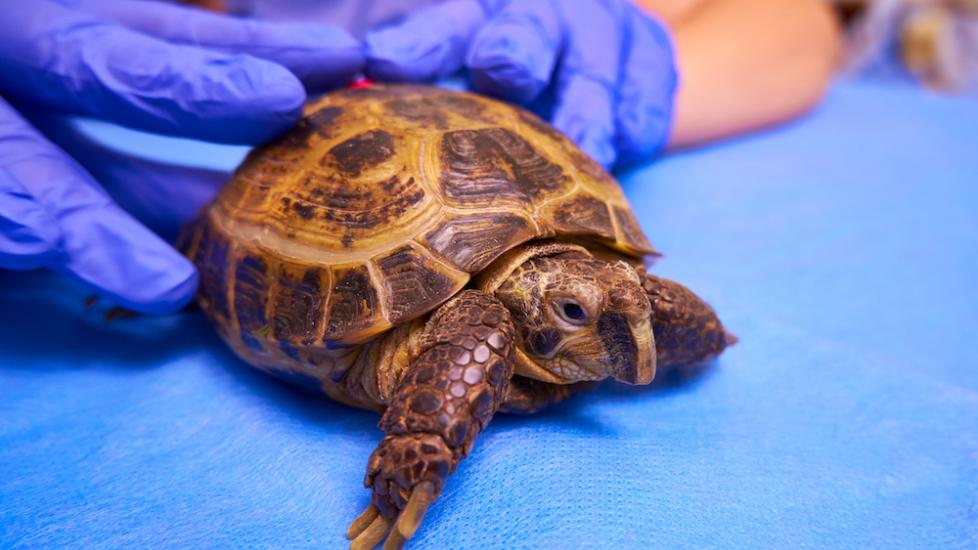Overgrown Beak in Turtles and Tortoises
What Is Overgrown Beak in Turtles and Tortoises?
Overgrown beaks in turtles and tortoises can occur in pet turtles and tortoises for multiple different reasons. The beak is composed of keratin that attaches to the underlying bone, and the keratin of the beak is called the rhamphotheca. Abnormal growth of the beak can be commonly observed and can be corrected successfully with time and patience.
Symptoms of Overgrown Beak in Turtles and Tortoises
-
Visual overgrowth
-
Abnormal beak wear
-
Difficulty picking up food items
-
Difficulty eating or decreased appetite
-
Recent head trauma
Causes of Beak abnormalities in Turtles and Tortoises
-
Poor beak alignment
-
Lack of wear: often turtles and tortoises will naturally wear their beak down when provided the correct diet and environment
-
Improper diet or care: this can lead to nutritional secondary hyperparathyroidism which can manifest as an overgrown beak
-
Vitamin issues: In addition to calcium being a factor that can alter beak growth, a diet low in vitamin A can also cause issues with keratin formation which can lead to an abnormally grown beak, requiring medical intervention
-
Fractured jaw/injury not healing properly
-
Swellings or masses within the mouth
How Veterinarians Diagnose Overgrown Beak in Turtles and Tortoises
Veterinarians can diagnose an overgrown beak with a through history and physical examination. Obtaining a complete history from a pet parent can help a veterinarian determine if there is a risk for nutritional disease in a turtle or tortoise with an overgrown beak.
Physical examination with an oral examination can allow a veterinarian to determine if there are any specific abnormalities along the face or within the oral cavity that could be causing any abnormalities.
If any jaw fractures are observed or there is a history of head trauma, a radiograph or X-ray can help determine where a fracture is located and how it can be corrected.
Treatment of Overgrown Beak in Turtles and Tortoises
Providing appropriate care and nutrition is paramount in correcting overgrown beaks in turtles and tortoises long-term. These factors include appropriate temperature, humidity, and diet, which can directly impact the growth of the beak.
Adjustments to care will be recommended to help improve the overall wellbeing of your pet. Dietary changes are often recommended to correct for nutritional diseases such as secondary nutritional hyperparathyroidism. Some medications that can be prescribed for diseases such as secondary nutritional hyperparathyroidism include oral calcium supplementation such as calcium glubionate and calcium powder.
Turtle and Tortoise Beak Trimming
A veterinarian can trim your pet’s beak under manual restraint or with some light sedation. Manual restraint can often be difficult to perform due to the strong muscles in the neck of many turtle and tortoise species. Using light sedation can decrease the stress on the animal and improves the ability to manipulate the head to trim the beak.
Pet parents can try to trim a turtle or tortoises beak at home; however, sometimes it can be difficult and dangerous to your pet turtle or tortoise if not done correctly. Utilizing a veterinarian will help make it a better experience for both you and your pet turtle or tortoise.
How Much Does it Cost to Trim a Beak?
The cost of a beak trim can vary based on multiple factors. Some pets will not allow physical manipulation of the head to allow for a beak trim. This can lead to the need for sedation which can increase the price. The cost breakdown for a beak trim at a veterinarian might be similar to the below costs, but will depend on the clinic and the size of your animal that requires a beak trim.
Potential cost of a tortoise beak trim:
-
Exam fee: $100–$180
-
Sedation: $30–$80
-
Beak trim: $30–$50
-
Additional medications: $30–$50
Prices for a beak trim could range from $160–$360 depending on what is needed to successfully perform a beak trim.
Recovery and Management of Overgrown Beak in Turtles and Tortoises
Initially animals with overgrown beaks that are undergoing correction may require softer food items until the beak is improved. Corrections to husbandry are imperative in correcting beak growth, but usually there are no immediate additional care items that are needed.
Overgrown beaks can be prevented by providing appropriate husbandry and nutrition to your pet turtle and tortoise. Correcting an overgrown beak can take several months because keratin is replaced and grows slowly.
Overgrown Beak in Turtles and Tortoises FAQs
How do you fix an overgrown tortoise beak?
Initial correction of an overgrown beak will include trimming the beak back with multiple different tools depending on its severity.
Why is my tortoise beak overgrown?
Multiple different factors can influence beak growth but the most common ones include nutritional disorders such a nutritional secondary hyperparathyroidism or hypovitaminosis A.
Do tortoise beaks need to be trimmed?
Generally, tortoise/turtle beaks do not need to be trimmed; appropriate diet and husbandry allows for normal wear to occur throughout their life.
What does an overgrown beak look like on a tortoise?
An overgrown beak on a tortoise looks like they have a very large and extended rhamphotheca which extends and covers the bottom portion of the jaw. In a normal beak, you can see both the top portion and the bottom portion of the jaw on visual examination.
Can my tortoise's beak get too long?
Yes. A tortoise’s beak can become too long where the animal is unable to eat properly. This can lead to decreased food consumption and be caused by underlying nutritional disorders.
Featured Image: Getty/Dmitry Andreev
